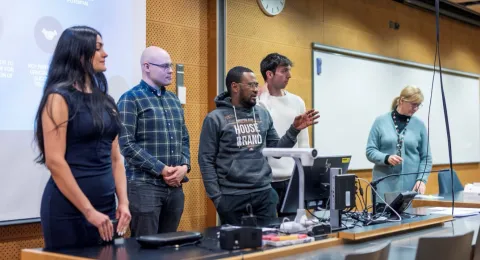Miia John, PhD researcher at LUT University, has a positive problem. The CEMP course, or Circular Economy for Materials Processing, which deals with the circular economy of the mining industry, is so popular that the presentation of project works in the final seminar requires a minute schedule.
The course was born from a project financed by EIT RawMaterials, where eight international universities prepared study materials for mining engineering education. LUT brought to the pot excellence in separation technology. “The goal was to get the strongest expertise of each university available for all,” explains Professor Antti Häkkinen.
“Great presentation!” someone writes in the chatbox after group 13 presented on the kind of business model they built to utilize gypsum sludge in the manufacturing of bricks. The team consists of sustainability science students Kia Lindström, Debdulal Bishwas, Jenni Noki, Leena Heikinmaa, and Heli Mylly, who studies entrepreneurship and circular economy. Some of them also have chemical engineering studies under their belt, but no one had previous experience in the mining industry prior to taking this course. Mylly, who lives in Kajaani, laughs that she seems to be the closest to the industry quite literally, because the Terrafame mine is a few kilometers from her home. “I have to say that my own attitude towards the mining sector has changed from neutral to positive during the course; I have learned how things are done in Finland and how they work to develop them even further” Heli says.
The idea of the CEMP course is to unite students from different disciplines to solve the challenges of the circular economy across the mining sector, so that things are not only looked at through the eyes of engineers, but in a more diverse way. In the future, a social perspective will be added, as the teaching of social sciences will start at LUT next fall. “We want students to let their creativity run loose, and to learn to live with uncertainty,” says Miia John, the responsible teacher for the course, and continues: “The course requires a lot of work, but we haven’t had to give a single bad grade yet. Students must be able to demonstrate group activities and set boundaries for their work. There aren’t necessarily right answers.” Miia John reminds us that studying at university is not rote learning, as that won’t take you far. The more you read and research, the more you realize the texts are models and theories that can be tested, and from which you can find something important and new.

CEMP is an applied course for Master’s students. John admits the course is challenging if one is only comfortable with teacher-led work and precisely guided work. “I wish that even I would have taken more risks during my studies and tried crazy ideas,” Miia John says now with the long experience gained both at university and in business life. At the end of the seminar, the audience smiles when one student presents the business model for his group, which studied the recycling of battery chemicals, which needs a capital investment of 92 million euros. “A very ambitious, but actually quite relevant plan,” comments Professor Häkkinen.
The work is done more and more often in networks and teams. Thus, the development of cooperation skills is an important part of the CEMP course. The teacher divides the students into groups, after which the group agrees on the division of work and communication with their instructor. As in real life, the groups have different people and tasks, from product development to manufacturing and sales. The students have different educational and cultural backgrounds, and some are already working. Heli Mylly works as a teacher at Kainuu Vocational School, and Jenni Noki works alongside her studies at the ELY center in Häme. Finding common time for group work is challenging. “We’ve only met in Teams,” laughs Kia Lindström, project manager of the gypsym sludge group. However, all members of the group agree that project work is an excellent way to learn and bring different skills together. Debdulal Bishwas feels the experience of group work will help him in the future, also in working life. The project work topics are real research problems, but both the students and the teachers of the course wish more companies would be involved and a genuine dialogue with them would be part of the process. Jenni Noki reminds that it was surprisingly difficult to find background information, which explains in part why contacts with companies are so important.
Project work is presented twice in the CEMP course. In the first seminar, you will hear what is going to be done, and in the final seminar you will get to know the solution and the business model. There is a possibility to pitch the work even a third time. The course’s connection to EIT RawMaterials has been preserved, and with the CEMP project work one can apply to the international Jump Starter program to continue developing the idea all the way to a start-up.
Text: Jaana Ryynänen, Coordinator for Xplorer network
Photos: LUT, Teemu Leinonen
